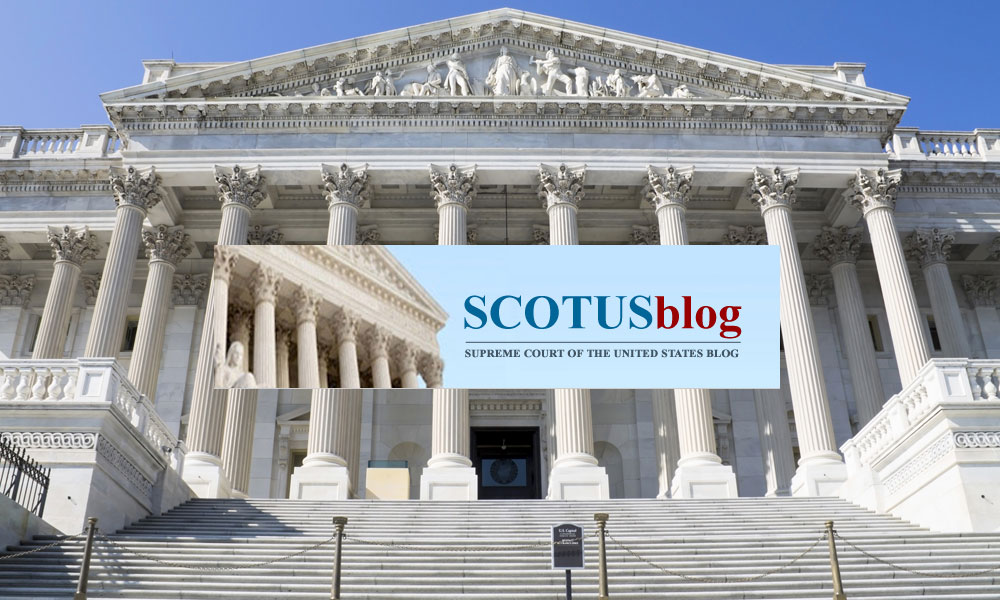Originally published July 13, 2012.
By Kelsey Pospisil
Chances are, you heard its name on June 28. You may have even visited it – along with 1.7 million of your closest friends.
SCOTUSblog was the go-to place for many people looking for a fast and accurate report of the U.S. Supreme Court’s decision on the constitutionality of the Patient Protection and Affordable Care Act.
But what is SCOTUSblog all about?
SCOTUSblog reporter Lyle Denniston, who has covered the high court for 54 years, calls his current home “an online clearinghouse for news about the Supreme Court.”
Says David Savage, the Los Angeles Times’ Supreme Court correspondent, “They do a heck of a job of putting up a whole lot of information about the Supreme Court week in and week out.”
What makes SCOTUSblog special? Says Jane Kirtley, professor of media ethics and law at the University of Minnesota and former executive director of the Reporters Committee for Freedom of the Press, “Providing context and accuracy is what sets them apart for me.” Kirtley praises the blog because “there is not a lot of idle speculation and rambling. I don’t see a lot of ego here.”
Publisher Tom Goldstein founded the blog in 2002 with his wife Amy Howe. Both are partners in the law firm Goldstein & Russell, P.C. in Washington, D.C. SCOTUSblog, funded entirely by its sponsor Bloomberg Law, has three full-time employees, three half-time employees, about 10 more regular contributors and another 100 people who write for the blog throughout the year, Goldstein says.
SCOTUSblog’s mission has changed dramatically over the past decade. Goldstein says the original goal was to get name recognition for him and Howe as well as the law firm. “As the blog’s influence and readership grew, we really decided that was the wrong mission, and the blog evolved considerably. It is now a completely journalistic enterprise that has no direct advertising goals at all.” The blog’s ambition is “educating the country about what’s going on with the court.”
Goldstein says most of his day is spent on work for the firm, with about 25 percent of his time devoted to the blog.
Goldstein and Howe’s law firm focuses on Supreme Court cases, which raises the obvious question of potential conflicts of interest. Goldstein says he and his wife are careful to make sure their day jobs don’t influence the blog. “We try very hard not to write about cases in which we’re involved. We never highlight our own cases.”
Savage says it’s not a potential conflict that bothers him much. “They don’t hide the fact that in at least some of the cases they are involved.”
And that’s crucial, says Kirtley, a former AJR columnist. “SCOTUSblog is more forthcoming in potential conflicts of interest than you might see in other instances.” She says that in blogging it is common for an author to have a vested interest in the topic of his or her blog – the key is disclosing it. In her view, trouble arises when a blogger isn’t up front with that connection.
“I don’t see ethical issues in what they’re doing there,” Kirtley says. “Their journalistic standards on reporting on the Affordable Care Act are better than some of the mainstream media.”
Goldstein says that while he knows the blog likely appeals first and foremost to the Supreme Court junkies of the world, he also hopes to share information with the average citizen.
The “Plain English” section of the blog written mainly by Howe, who Goldstein says spends about 90 percent of her workday on the blog, offers readers posts using terminology and concepts Goldstein says are likely more understandable to the ordinary American.
Says New York Times Supreme Court correspondent Adam Liptak, “I think Lyle Denniston does a good job of writing in plain English to begin with. And then Amy Howe supplements that nicely with even plainer English. An educated reader would benefit from both approaches.”
While Denniston says the blog’s audience “is overwhelmingly made up of lawyers and legal academics,” the staff is working hard to broaden its appeal.
The blog displayed its first “Made Simple” post on July 6. The post said, “During the Supreme Court’s summer recess, the blog will be publishing a series of posts that explain, in non-legal terms, some of the most important cases that will be decided in the new Term that starts October 1.”
June 28 was one of those days where both the pros and the amateurs paid a visit (or three) to SCOTUSblog. The site had 5.3 million page views the day of the Supreme Court’s health care decision and 1.7 million unique visitors. On a normal day, the blog has about 30,000 page views, Goldstein says.
The blog also survived two hacking attempts during the critical minutes.
Goldstein admits he “stupidly” commented in a Washington Post article the day before the Supreme Court decision that “after they hand it to Lyle, I expect 25 seconds after that, we’ll have it on the live blog. I would be surprised if the Associated Press can beat us.”
Goldstein says he ultimately decided to not focus on being first, saying it was more important to get it right. “People have given us too much credit to an extent,” he says. “People have not realized that all four wire services were before us.”
In a 7,000-word account published July 7 of what transpired on decision day, Goldstein described what he has deduced happened that morning, down to the second – and how CNN and Fox News came to incorrectly report the court’s decision. “My opinion is they tried incredibly hard…but they cared first and foremost about getting it right. And they believed they had it right. They weren’t guessing – they were just wrong.”
In his account, Goldstein says what likely happened to CNN and Fox News is that they read the part of the decision that says “Chief Justice Roberts concluded in Part III-A that the individual mandate is not a valid exercise of Congress’s power under the Commerce Clause and the Necessary and Proper Clause.” – and thought that was the ball game.
Goldstein explained in the post what happened next: “..the CNN producer says (correctly) that the Court has held that the individual mandate cannot be sustained under the Commerce Clause, and (incorrectly) that it therefore ‘looks like’ the mandate has been struck down. The control room asks whether they can ‘go with’ it, and after a pause, he says yes.
“The Fox producer reads the syllabus exactly the same way, and reports that the mandate has been invalidated. Asked to confirm that the mandate has been struck down, he responds: ‘100%.’ ”
Goldstein had initiated a conference call among the SCOTUSblog team and major news organizations, as well as the White House, to take place when the decision was handed down. He elaborated in his post under the headline of 10:07:50 a.m., “I have invited the major news organizations and the White House to listen in, so I can talk them through what we know in real time. Or at least that is my plan. NBC, CBS, ABC, NPR, The New York Times, the Wall Street Journal, and the Los Angeles Times are all on. But I have forgotten two: CNN and Fox News.”
In his play-by-play of events on the morning of June 28, which he calls his “first effort at real journalism”, Goldstein does not name those at CNN and FOX responsible for the incorrect reports.
“The names aren’t secret,” he says. “I think any reporter that’s involved in the process could tell you.” He says he felt including the names in his piece would seem salacious and not really add anything.
But Savage says he thinks that if Goldstein was going to allude to the producers, taking it a step further – for example, getting comment from them – would have been a good idea.
For his part, Goldstein says he thinks there is “too much focus on blaming people, rather than the news organizations, for what goes wrong.”
So does Goldstein’s foray into journalism presage similar efforts in the future? “I don’t see a next reporting project,” he told media news aggregator/blogger Jim Romenesko. “This was very special, because I know the subject well and was trusted by the people involved. And our site does relatively little enterprise reporting.”
The Supreme Court does not recognize SCOTUSblog as a journalistic institution, so it does not have its own press pass, Goldstein says – which in his view has advantages and disadvantages for the blog. Denniston is credentialed because he also covers the court for the radio station WBUR in Boston.
Senate Press Gallery Director Joe Keenan told Poynter.org’s Mallary Jean Tenore that in June 2010. SCOTUSblog “failed to show that they were separate from the law firm,” which is essential for obtaining a press pass according to the Senate Press Gallery’s criteria. The Supreme Court grants credentials only to reporters who already have press credentials.
Keenan told Poynter that “if a practicing lawyer applied to us, there is almost no way they would be credentialed,” although that’s not absolute. He told Poynter, “We would figure out how they operate, how they get their money and whether the publication is a separate entity.”
Goldstein responded in the Poynter article, “That wouldn’t make any sense as applied to us, because we don’t do any lobbying work… It certainly wasn’t my understanding, because if that had been told to me, I would have just said it wasn’t true.”
Now 81, Denniston started his reporting career in Nebraska City, Nebraska, in 1948. He has covered the Supreme Court for, among others, the Wall Street Journal, the Baltimore Sun, and the Boston Globe. A former AJR columnist, he has been with SCOTUSblog since 2004.
He describes the Supreme Court press room the day of the health care decision as crowded, with a lot of pushing and shoving. But even though June 28 was hectic and uncomfortable, Denniston says a job with SCOTUSblog is perfect for him at this point in his life. “I like not having any editor. I like not having any assignments. I like not having any deadlines. I’m completely liberated.”
He says he prefers working in the blog format because it allows him to write as much as he finds necessary. “I like the fact that the space is not limited. The columns in newspapers are shrinking. Time available on broadcast has always been quite brief.”
Goldstein says of Denniston, “He’s a little bit of a technophobe, but he has so embraced the Web as a vehicle for getting information about the court out to the people.”
Goldstein says the blog’s traffic has grown by about 25 percent each year since its launch. He expects that number to be greater this year but says he maintains a realistic view of who SCOTUSblog’s core audience is. “We’re very humble about what it is we can do, and who it is that will want to read that.” He adds, “We live a life of relative anonymity. That’s going to be the case except for these spikes. And that’s fine.”
Goldstein says working with a journalist as professional as Denniston helps the blog maintain its journalistic integrity, which is important since it is constantly urged to post items by people who want to influence the court. “We refuse to do that,” Goldstein says. “That’s just really consistent with how Lyle approaches things as well.”
Denniston, who calls the law “deeply fascinating,” says, “This is a rigorous job. I work very hard at it. It takes a lot of energy to do it well.”
Any plans to retire? Not so much.
“I’m 81 years old, but I’m in excellent health. I can’t imagine how boring retirement would be.”
Kelsey Pospisil, an AJR editorial assistant, is a master’s student at the Philip Merrill College of Journalism at the University of Maryland.









Leave a Comment